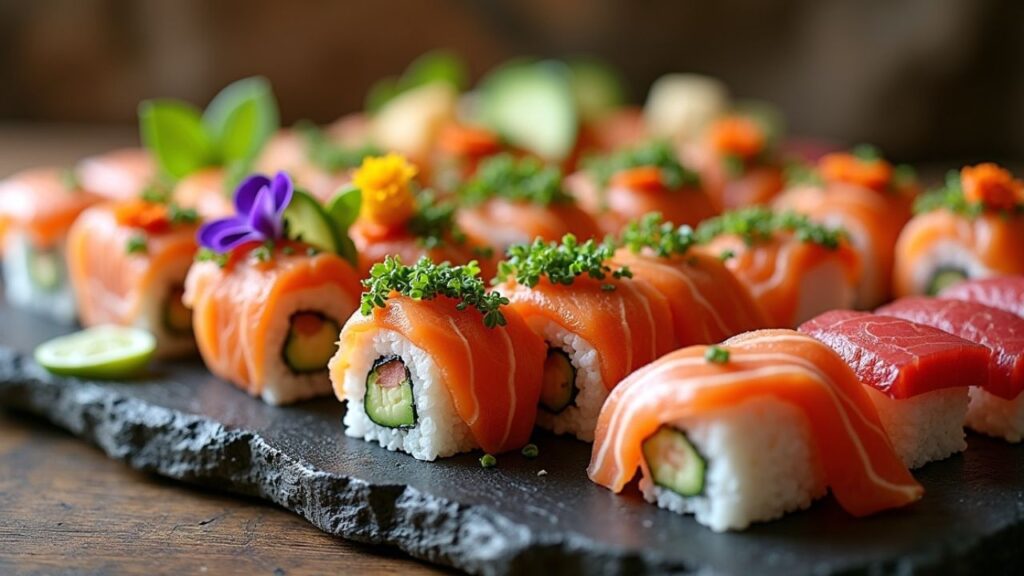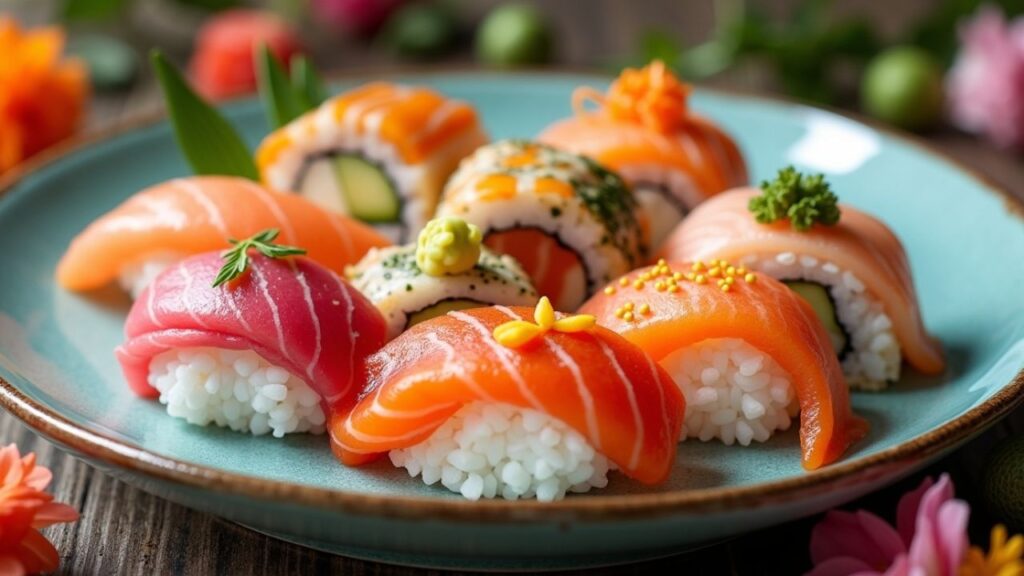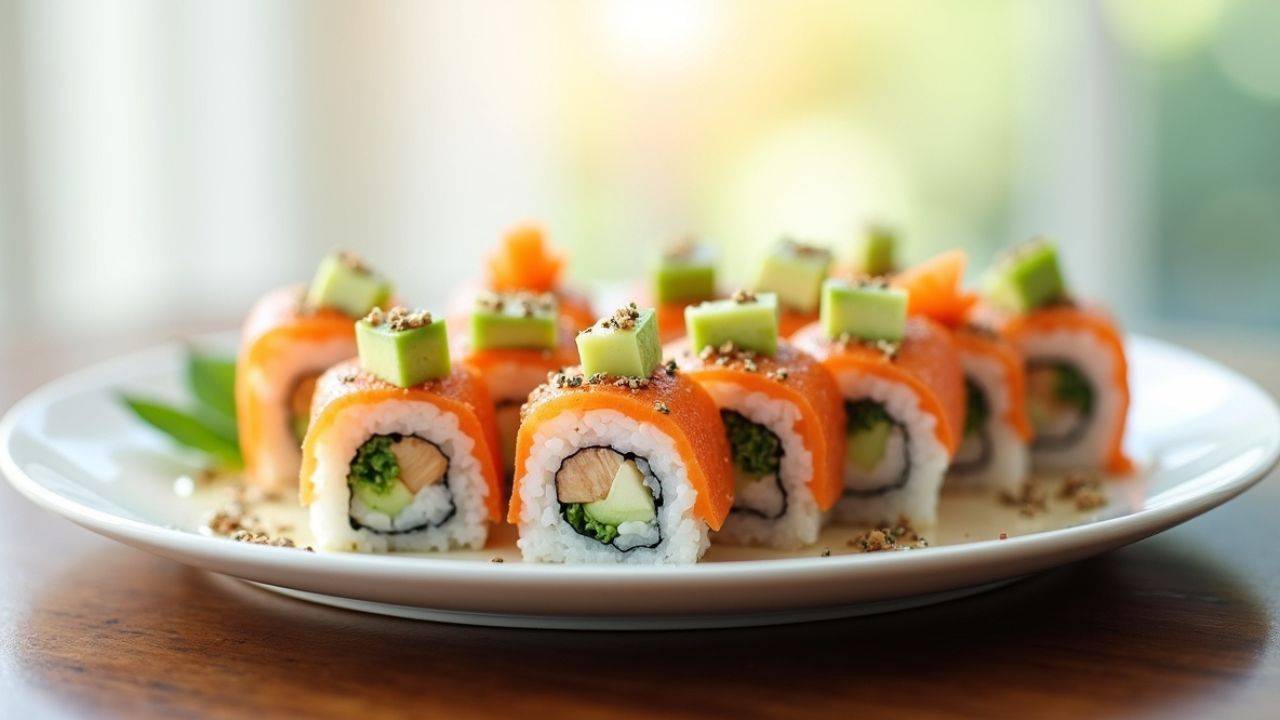Passover is meaningful, is a remembering, and takes place at a time when you are around family. But it’s honest to say that, after a few days, the food routine may get rather boring. Believe me, matzah pizza is seriously amazing, but what if you could eat kosher for pesach sushi recipe that was fresh and tasted good all the while it was in line with the Passover kosher rules? Believe it or not, you can make surprisingly enjoyable – and tasty – filling, and really interesting kosher for Pesach sushi. Have no more rules – it is only on how to be creative in the kitchen and have fun. In this article I will tell you everything you need to know to make Pesach sushi so that your holiday dinners go from boring to amazing.
These are rolls which are not only ok to eat, but they are also pretty tasty and pretty good looking. I think we get started.

Why Kosher for pesach sushi recipe? A Fresh Twist on Tradition
Why even try sushi for Passover? The answer is simple: happiness and diversity! Passover limitations (no chametz, which are leavened grains, and for many Ashkenazi Jews, no kitniyot, which are legumes, rice, maize, etc.) naturally limit what we may eat. This might make you tired of eating. A kosher sushi dish for Pesach adds excitement, gives people a lighter, fresher choice among the heavier holiday foods, and is a great way for families to prepare together. It honors the fact that there are so many kosher fish and veggies to eat. It’s a way to celebrate the spirit of the holiday, which is freedom from regulations, by using your imagination to follow the rules.
It also looks great and feels like a wonderful treat, which makes your Seder table or any Passover meal seem even more special and celebratory. It shows that dining kosher during Passover doesn’t have to be dull!
Understanding the Passover Rules: Your Sushi Blueprint
First we understand the Passover guidelines to help us guide our very own kosher Pesach sushi course before going into the delicate matters. The major thing that you can’t eat is chametz, namely leavened products produced from wheat, barley, rye, oats, and spelt. So the sushi rice cannot be used this at the same time. Other Jews avoid kitniyot (rice, maize, beans and soy sauce) while still other Ashkenazi Jews do not keep kosher. In Sephardic traditions rice and kitniyot are usually permitted. In this essay, Ashkenazi in a stricter way of doing things so, therefore our sushi has to be Pesach but has to exclude rice and soy sauce. Your family or your rabbi have laid out the rules and your rabbi can always tell you what is right or answer your questions.
Good news? The fact is that there are so many good options. We will take care that everything is 100% kosher for Pesach from certified seafood, vegees, smart rice and soy sauce replacements.
Essential Kosher for Pesach sushi recipe Ingredients: Your Shopping List
Gathering the right ingredients is your first step to Passover sushi success. Here’s your essential shopping list, focusing on freshness and Passover compliance:
- The “Rice” Alternatives: This is key! Matzah farfel (broken-up matzah) softened and seasoned is a popular, accessible base. Riced cauliflower (steamed and very well-drained) offers a grain-free, veggie-packed option. Quinoa (if permitted by your custom – some authorities allow it as it’s not one of the five grains, but check!) is another great binder.
- Nori Sheets: These roasted seaweed sheets are inherently kosher for Passover (check the packaging for any Passover certification if concerned, but plain nori is generally considered kosher and kitniyot-free).
- Fresh Fish: Opt for high-quality, sushi-grade fish certified kosher for Passover. Popular choices include salmon, tuna, and yellowtail. Crucially, ensure it’s prepared according to kosher fish rules (fins and scales) and has reliable Passover certification.
- Vegetables: Cucumber (peeled and julienned), avocado, asparagus (blanched), carrots (julienned, sometimes lightly steamed for flexibility), scallions (green parts only, if avoiding kitniyot roots), and bell peppers add color and crunch. Ensure all are thoroughly checked for insects.
- Binding & Seasoning: Kosher-for-Passover mayonnaise is essential for binding cauliflower “rice” or adding creaminess. Lemon juice provides acidity. Kosher salt and freshly ground black pepper (check certification) are basics. For umami, look for kosher-for-Passover fish sauce or vegetable broth powder (certified). Horseradish (fresh or prepared, certified) adds kick.
- The Soy Sauce Swap: Coconut aminos (ensure Passover certification, as some brands may have additives) are the go-to substitute, offering a similar salty-sweet umami flavor without soy. You can also make a simple sauce with fish sauce, lemon juice, water, and a touch of honey.
Must-Have Tools for Easy Kosher for Pesach sushi recipe Making (No Fancy Gear Needed!)
You don’t need a professional sushi kitchen to make fantastic kosher Pesach sushi! Here’s what will make the process smooth and enjoyable:
- Bamboo Sushi Mat (Makisu): This is the one specialty item highly recommended. It helps tightly roll your sushi. Wrap it tightly in plastic wrap before use (and replace the wrap if it tears) to prevent sticking and for easy Passover cleaning.
- Sharp Knives: A very sharp chef’s knife for slicing fish and vegetables thinly and evenly, and a sharp serrated knife for cleanly cutting the finished rolls without squishing them.
- Cutting Boards: Dedicate one for fish and one for vegetables to prevent cross-contamination and for kosher separation.
- Mixing Bowls: For preparing your “rice” alternatives and fillings.
- Vegetable Peeler & Julienne Peeler/Mandoline (Optional but Helpful): Makes quick work of creating thin, uniform vegetable strips (julienne) for fillings. A knife works fine too!
- Plastic Wrap: Essential for wrapping the bamboo mat and also useful for handling sticky fillings or covering components.
- Damp Clean Cloth/Towel: Keep this handy to wipe your knife between cuts for clean slices and to cover rolled sushi before slicing to prevent drying out. No need for expensive gadgets – these basics are perfect for creating beautiful Pesach sushi at home.

Passover Rice Swaps: Matzah & Cauliflower
The heart of traditional sushi is the rice. For kosher sushi for Passover, we need brilliant substitutes. Let’s explore the two most popular and effective options:
- Matzah Farfel “Rice”: Separate the plain matzah into small pieces, sometimes called farfel. After 30–60 seconds, place it on a plate and submerge it in cold water. Soft without being mushy is the desired texture. Carefully pour off the excess water using a spoon and a fine-mesh sieve. Return it to the sink. For better binding, add kosher salt, lemon juice, and a touch of Passover mayo (about 1 tablespoon for every cup of drained farfel). The ideal texture would stay together somewhat when pressed, without becoming too sticky. This substitute has the texture of very soft grains and a pleasant flavor that leans slightly toward nuts.
- Cauliflower “Rice”: Rice as fresh cauliflower florets in a food processor to resemble rice grains (pre-rice works fine). Most importantly: You have to reduce the moisture. Rice the cauliflower, steam the riced cauliflower for 3 – 5 minutes until tender but not mushy. Lay a clean kitchen towel or some paper towels and spread it thinly, letting it cool completely. Next assemble the towel and try to wring out as much water as you can possibly remove without drowning yourself – this is an absolutely necessary non soggy Pesach sushi step. Put the dry cauliflower into a bowl. Add salt and a bit of lemon juice, and dress the entity with Passover mayo (about 1 or 2 tbsp to 1 cup of squeezed cauliflower).
- For stickiness here is the key to the mayo. There is no discernable flavor so it is a great base to add in other things. For added binding power some folk add a beaten egg to the mix (and a quick sauté before rolling, when cool).
Prepping Perfect Fillings: Fish and Veggies for Kosher for Pesach sushi recipe
Freshness and proper preparation are paramount for your kosher Pesach sushi fillings:
- Sushi-Grade Fish: Purchase only the freshest fish from a reputable source with clear kosher-for-Passover certification. Keep it refrigerated until ready to use. Right before assembling, slice it against the grain into thin, even strips or small rectangles. Handle it minimally.
- Vegetables: Wash all vegetables thoroughly and check meticulously for insects according to kosher guidelines. Peel cucumbers and carrots. Cut vegetables into long, thin matchsticks (julienne) for easy rolling. Blanch harder vegetables like asparagus for 1-2 minutes to soften them slightly, then plunge into ice water to stop cooking and retain bright color. Pat all vegetables completely dry with paper towels before using – moisture is the enemy of a tight roll! Avocado should be just ripe (slightly soft but not mushy) and sliced thinly right before assembly to prevent browning (a little lemon juice helps).
- Other Fillings: Cooked, flaked kosher crab stick (check certification) or smoked salmon (lox style, certified) are great options. Cream cheese can be used if it’s kosher for Passover and part of your tradition (ensure certification). Keep fillings simple, especially when starting – 2-3 ingredients per roll work best.
Difference Table
| Regular Sushi Ingredient | Passover-Friendly Swap | What Changes? | Pro Tip |
| Sushi Rice | Matzah farfel or riced cauliflower | Texture becomes grain-free & lighter | Squeeze cauliflower DRY! Wet = soggy rolls |
| Soy Sauce | Coconut aminos (Passover-certified) | Slightly sweeter, less salty | Mix with lemon juice for tang |
| Imitation Crab | Passover-certified lox or cooked whitefish | Fresher, cleaner flavor | Great for beginners! |
| Cream Cheese | Passover-certified cream cheese (if allowed) | Tastes identical – check hechsher! | Skip if avoiding kitniyot |
| Sesame Seeds | Toasted quinoa (if permitted) or omit | Less crunchy, but still tasty | Adds nutty flavor without kitniyot |
Conclusion
It turns out that making great tasting kosher sushi during Passover that is real is not just possible, but it can be a whole lot of fun By learning the rules, using innovative replacements like matzah farfel or cauliflower rice and learning a few easy skills, you could discover a world of great fresh, vivid flavors that go well with Passover custom. With it, you don’t get bored with meals making them fun and more rewarding. This Passover sushi recipe proves that you can be creative and filling and opt for tasty food this Passover. You can also make classic rolls, amusing hand rolls or quick sushi bowls. Roll up your sleeves, get all your certified ingredients together and expect to wow.
With Pesach around the corner, it is time to start learning how to make kosher Pesach sushi. It gives you freedom to serve on your dining table. Happy Chag!
FAQ’s
1. Wait, really? Can I have sushi during Passover?
Absolutely! While traditional rice and soy sauce are out, clever swaps like seasoned matzah farfel or cauliflower “rice,” plus coconut aminos for dipping, let you enjoy delicious, fully kosher-for-Passover sushi. It’s all about creative substitutions.
2. What do I use instead of rice?
The two best options are matzah farfel (quickly softened, well-drained, and seasoned) or cauliflower rice (steamed and thoroughly squeezed dry, then bound with Passover mayo). Both create a tasty base that holds your sushi together.
3. How do I replace soy pesach sushi recipe?
Coconut aminos (look for Passover certification!) are the easiest swap, offering a similar salty-sweet flavor. You can also make a simple homemade sauce with Passover fish sauce, lemon juice, water, and a touch of honey.
4. My rolls keep falling apart! Help!
Don’t worry! This is common. Ensure your “rice” has enough binder (like Passover mayo), press it firmly onto the nori, avoid overfilling, roll tightly using the bamboo mat, and seal the nori edge well with water. Squeezing ALL moisture from cauliflower rice is crucial.
5. Are there easier options than rolled sushi?
Definitely! Try sushi bowls (poke-style) – just layer your “rice,” fish, and veggies in a bowl and drizzle with sauce. Hand rolls (Temaki) are also fun and simple – roll ingredients into a cone shape with a nori half. Less rolling, same great flavors!
